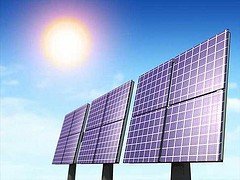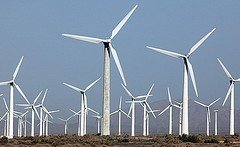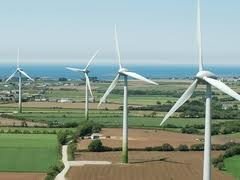In Focus
Japan eyes renewable energy deregulation
Japanese cabinet ministers will pursue an easing of rules on building geothermal, wind and hydraulic power plants to boost renewable energy use after the Fukushima nuclear crisis, according to Reuters, citng a Nikkei report.
Japan eyes renewable energy deregulation
Japanese cabinet ministers will pursue an easing of rules on building geothermal, wind and hydraulic power plants to boost renewable energy use after the Fukushima nuclear crisis, according to Reuters, citng a Nikkei report.
Wind farm and solar park financing reaches a record $41.8b in Q3 2011
It was only $33 billion in the same quarter last year.
Japan still considering total nuclear power pullout
Japan is still contemplating a complete closure of its nuclear power stations as one option for the country's future energy policy, according to the country's economy minister Yukio Edano.
Wind energy to eclipse aerospace as top user of advanced composites by 2020
The demand for advanced structural materials by wind turbine makers will surge five-fold from $2.5b in 2011 to $15.4b in 2020.
China takes on Western wind turbine suppliers
China's windmill makers face competition head on with at least $15.5 billion in state-backed credit.
Hello, sunshine: US to fund $250m for 51 solar power projects in Thailand
The installations will range in size from one megawatt (MW) to 50MW, with a final total capacity of approximately 520MW.
Czech companies keen on Indian power sector
Czech companies have expressed interest to participate in the fast-growing Indian power sector.
China Guangdong up for a 650 million-pound bid for UK-based Kalahari Minerals
China Guangdong has reopened talks with Kalahari over a 270 pence-a-share bid, according to a Bloomberg report.
Asian Power Awards 2011 winners announced
The best power companies were recognised at this year's awards held in Malaysia.
Vietnam attracts clean energy investors
Vietnam has become the attractive destination for foreign clean energy investors with shortage in energy and willingness to develop clean energy sources.
Japan to lift restrictions on Fukushima Evacuation Zone
“I plan to take measures to lift the Emergency Evacuation Preparation Zone this week if possible,” said Goshi Hosono, the minister in charge of responding to the nuclear crisis.
Vietnam now the aiming point of clean energy investors
Lacking energy and wishing to develop clean energy sources, Vietnam has become the attractive destination for foreign clean energy investors. When announcing the project to build a solar panel factory in HCM City in March, the US First Solar group aims to make more profits with the low-cost solar cell technology, about 78 cent per watt. The project by First Solar to increase the capacity from 1.4GW to 2.7GW, which is expected to create 600 jobs in Vietnam, has the total investment capital of one billion dollars. IC Energy has also set up a solar panel factory in the Chu Lai Open Economic Zone with the investment capital of more than 390 million dollars. Meanwhile, German Roth&Rau has also invested 275 billion dong in a factory in the Hoa Lac High-Tech Park. A lot of other large-scaled wind power projects in Vietnam have also been kicked off. The 99MW wind power plant in Bac Lieu province has the total investment capital of 4500 billion dong. One of the biggest equipment suppliers of the project is the US-based GE Group. A project on wind power plant in Tra Vinh province has been developed by German EAB, which is expected to have the capacity of 30MW. Meanwhile, a project in Soc Trang is expected to have the capacity of 300MW when becoming operational. Meanwhile, sources say that the US Cenergy Power is moving ahead with the solar energy projects in the two islands of Cat Hai and Bach Long Vi. Investment funds jump into clean energy sector Of the 150 million euro worth of ODA (official development assistance) capital granted by the German government to Vietnam in 2010-2011, 33 percent of the capital will be poured into the energy sector and climate change. This has helped catch more attention from foreign investors when considering investment plans in Vietnam. Besides this, the market now has favorable conditions to develop, because a lot of investment funds which plan to funnel capital into the recycle energy sector have been established. A World Bank’s survey on the energy for Asia conducted in 2010, shows that Vietnam has great advantages to make wind power with the total potential capacity of 500,000 MW, which is 200 times higher than the capacity of Son La hydropower plant and 10 times higher than the forecast total electricity capacity to be reached by 2020. Vietnam has 8.6 percent of its area which is believed to have “good” and “very good” potentials to set up big-scaled wind power stations, and more than 40 percent of land in rural areas for small-scaled stations. Meanwhile, scientists have warned that Vietnam may meet big problems in the future, when the electricity consumption is forecast to increase by 20 percent, while the electricity output increases by 13 percent only. Indochina Capital has set up MRRF with the capital of 50 million dollars, a fund which plans to pour money into recycle energy and environment projects. The fund also plans to mobilize 150 million dollar worth of capital from other sources which will then be injected in wind, solar power plants, small hydropower plants and energy saving projects. Prior to that, Dragon Capital announced the establishment of the regional Mekong Brahmaputra fund which specializes in making investment in recycle energy, clean water production and waste treatment. To date, 45 million dollars worth of capital has been mobilized from financial institutions such as FMO, ADB, Finnfund and BIO, while the capital is expected to increase to 100 million dollars this year. IFC and Norwegian SN Power have also agreed on the establishment of InfraVentures which specializes in seeking investment opportunities in recycle energy projects. For the last many years, IFC has been well known as a big investor in energy saving and clean production sectors.
Japan’s new energy policy to take effect by early 2013
To make up for the decline in nuclear power generation, the country will boost power conservation and the use of renewable energy in its new electricity portfolio.
Indian Hydro Project Exposes World Bank's Abuse of Climate Funds
If the World Bank and an Indian power utility have their way, the Rampur hydropower project in Northern India will increase global CO2 emissions by 15 million tons, at a cost of $164 million to unsuspecting energy consumers in Sweden. The project is a textbook example of how hydropower companies and other investors, with support from the World Bank, are gaming the system of climate finance. Rampur is a 412-megawatts hydropower project on the Satluj River in the Indian state of Himachal Pradesh. Satluj Jal Vidyut Nigam Limited (SJVN), an Indian hydropower company originally created by the World Bank, signed an agreement with the local government to implement the project back in 2004. The Indian Prime Minister laid the foundation stone in 2005. The World Bank approved a loan of $400 million for Rampur in 2007. Throughout this process, the hydropower company SJVN assured the public and its lenders that the scheme was a "least cost" project and would remain financially viable even under adverse hydrological conditions. At no time did it indicate that the project depended on carbon credits to go forward. Several years into project construction, t
India, China to exhibit growth in nuclear energy: IAEA
The International Atomic Energy Agency feels that the global atomic sector would largely be driven by countries like India and China.
Natural gas demand to increase by 60% by 2030
China’s demand for natural gas alone is projected to grow more than five times from the current 20billion cubic metres to 110billion cubic metres by 2015.
Myanmar hydroelectric project to proceed amid objections
Myanmar will go ahead with construction of a major dam along its main river despite opposition from ethnic minorities and environmentalists.

















 Advertise
Advertise



















